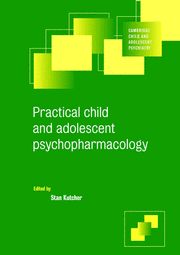Book contents
- Frontmatter
- Contents
- List of contributors
- Preface and acknowledgements
- 1 Child and adolescent psychopharmacology at the turn of the millennium
- 2 Developmental psychopharmacology
- 3 Clinical aspects of child and adolescent psychopharmacology
- 4 Depression
- 5 Bipolar mood disorders: diagnosis, etiology, and treatment
- 6 Schizophrenia and related psychoses
- 7 Obsessive–compulsive disorder
- 8 Anxiety disorders
- 9 Attention-deficit/hyperactivity disorder
- 10 Pervasive development disorder
- 11 Aggressive behavior
- 12 Adolescent substance use disorder
- 13 Tic disorders and Tourette's syndrome
- 14 Eating disorders and related disturbances
- 15 Medical psychiatric conditions
- Index
14 - Eating disorders and related disturbances
Published online by Cambridge University Press: 31 August 2009
- Frontmatter
- Contents
- List of contributors
- Preface and acknowledgements
- 1 Child and adolescent psychopharmacology at the turn of the millennium
- 2 Developmental psychopharmacology
- 3 Clinical aspects of child and adolescent psychopharmacology
- 4 Depression
- 5 Bipolar mood disorders: diagnosis, etiology, and treatment
- 6 Schizophrenia and related psychoses
- 7 Obsessive–compulsive disorder
- 8 Anxiety disorders
- 9 Attention-deficit/hyperactivity disorder
- 10 Pervasive development disorder
- 11 Aggressive behavior
- 12 Adolescent substance use disorder
- 13 Tic disorders and Tourette's syndrome
- 14 Eating disorders and related disturbances
- 15 Medical psychiatric conditions
- Index
Summary
Introduction
In the last several decades, there have been significant advances in our knowledge of the pharmacologic treatment of the eating disorders in adults. The short-term efficacy of antidepressant agents in bulimia nervosa has been well documented in double-blind, placebo-controlled trials. Although the role of medication in anorexia nervosa remains less clearly established, recent studies have suggested that there may be a role for medication in some stages of the illness. Additionally, the syndrome of binge eating disorder has been recently described and will likely be a focus of future psychologic and pharmacologic treatment research. Despite the fact that these eating disorders frequently have their onset during adolescence and early adulthood, most of the medication trials have been conducted with subjects over the age of 18, and their results may not be generalizable to children and adolescents.
In DSM-III-R (American Psychiatric Association, 1987), the eating disorders anorexia nervosa and bulimia nervosa were grouped with other disorders usually first evident in infancy, childhood, or adolescence. In DSM-IV (American Psychiatric Association, 1994), they have been moved into a separate category, titled Eating Disorders. Nonetheless, anorexia nervosa and bulimia nervosa can exist in childhood, typically have their onset in adolescence, and are intimately related to growth and development. The feeding disorders of infancy or early childhood remain in the childhood section of the DSM-IV and will not be discussed in this chapter as they largely occur prior to age 6 and are overwhelmingly treated with psychotherapeutic techniques.
Keywords
- Type
- Chapter
- Information
- Practical Child and Adolescent Psychopharmacology , pp. 410 - 430Publisher: Cambridge University PressPrint publication year: 2002
- 7
- Cited by

